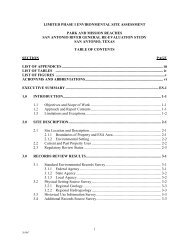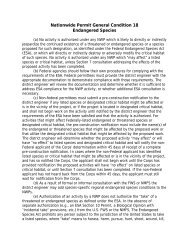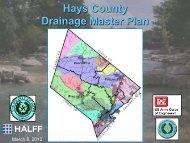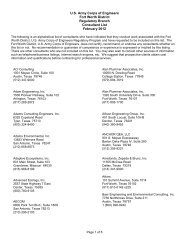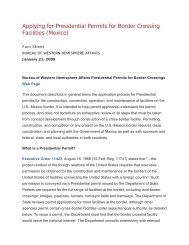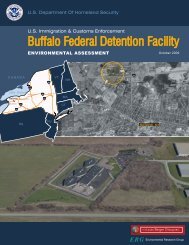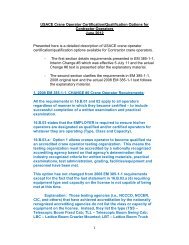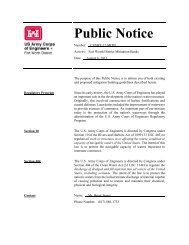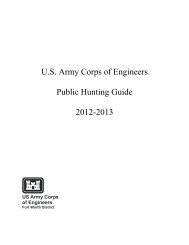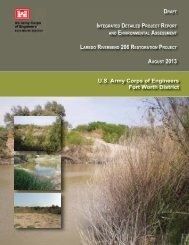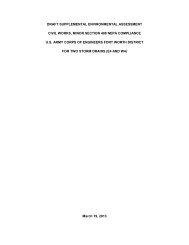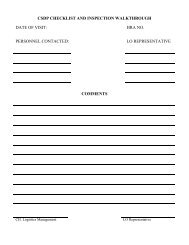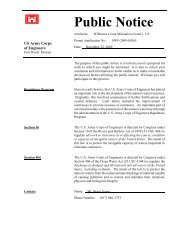environmental assessment us border patrol, tucson sector
environmental assessment us border patrol, tucson sector
environmental assessment us border patrol, tucson sector
You also want an ePaper? Increase the reach of your titles
YUMPU automatically turns print PDFs into web optimized ePapers that Google loves.
3-13123456789101112131415161718192021222324252627282930313233343536373839404142434445pear, rabbitbr<strong>us</strong>h, Arizona threeawn, and tobosa grass. There is evidence of livestock grazingactivity within and adjacent to the Alternative 2 site.3.5.1.3 Alternative 3The 18.2-acre Alternative 3 site is located across Geronimo Trail, to the east of the Alternative 2site. The dominant vegetation observed within the undeveloped Chihuahuan desertscrubcommunity at the site consisted of western honey mesquite, creosote b<strong>us</strong>h, tumbleweed, andfour-wing saltb<strong>us</strong>h. Other plants sparsely distributed at the site included cholla, sotol, soaptreeyucca (Yucca elata), purple prickly pear, rabbitbr<strong>us</strong>h, Arizona threeawn, and tobosa grass.3.5.1.4 Alternative 4In general, the vegetation community at the Alternative 4 site was dominated by western honeymesquite, purple prickly pear, creosote b<strong>us</strong>h, four-wing saltb<strong>us</strong>h, soaptree yucca, and centuryplant (Agave parryi). Rabbitbr<strong>us</strong>h, cholla, southwestern thornapple (Datura wrightii), andtobosa grass were sparsely distributed throughout the site.Several Arizona alder (Aln<strong>us</strong> oblongifolia),cottonwood (Popul<strong>us</strong> sp.), western hackberry(Celt<strong>us</strong> reticulata), and oak (Querc<strong>us</strong> spp.) trees,which appeared to have been planted years ago,were observed near the older home and man-madepond at the site. Western honey mesquite, soaptreeyucca, rabbitbr<strong>us</strong>h, cholla, creosote b<strong>us</strong>h, horseweed(Conyza sp.), catclaw (Acacia greggii), and sacaton(Sporobol<strong>us</strong> sp.) were observed within CottonwoodDraw (Photograph 3-1) on the northwesternboundary of the site. No mature riparian specieswere present within the draw.The vegetation community of the undeveloped ridgeon the eastern portion of the site was dominated byhoney mesquite, creosote b<strong>us</strong>h, four-wing saltb<strong>us</strong>h,cholla, and purple prickly pear. A few ocotillo,century plant, soaptree yucca, ephedra (Ephedratrifurca), and lechuguilla (Agave lecheguilla) werealso observed on the ridge (Photograph 3-2).Photograph 3-1. Vegetation within CottonwoodDraw at the Alternative 4 site3.5.2 Environmental Consequences3.5.2.1 No Action AlternativeThe No Action Alternative would preclude theconstruction, operation, and maintenance of the Photograph 3-2. Rocky ridge on the eastern portionproposed FOB, and vegetation would not beof the Alternative 4 sitedisturbed or removed. Indirect impacts from illegalactivity would continue. More agents would be required to <strong>patrol</strong> the remote eastern zones of theUSBP Douglas Station’s AOR to account for the necessary drive time to their <strong>patrol</strong> areas.Douglas FOB EADraftAug<strong>us</strong>t 2011



